The Xbox One: Hardware Analysis & Comparison to PlayStation 4
by Anand Lal Shimpi on May 22, 2013 8:00 AM ESTPower & Thermals
Microsoft made a point to focus on the Xbox One’s new power states during its introduction. Remember that when the Xbox 360 was introduced, power gating wasn’t present in any shipping CPU or GPU architectures. The Xbox One (and likely the PlayStation 4) can power gate unused CPU cores. AMD’s GCN architecture supports power gating, so I’d assume that parts of the GPU can be power gated as well. Dynamic frequency/voltage scaling is also supported. The result is that we should see a good dynamic range of power consumption on the Xbox One, compared to the Xbox 360’s more on/off nature.
AMD’s Jaguar is quite power efficient, capable of low single digit idle power so I would expect far lower idle power consumption than even the current slim Xbox 360 (50W would be easy, 20W should be doable for truly idle). Under heavy gaming load I’d expect to see higher power consumption than the current Xbox 360, but still less than the original 2005 Xbox 360.
Compared to the PlayStation 4, Microsoft should have the cooler running console under load. Fewer GPU ALUs and lower power memory don’t help with performance but do at least offer one side benefit.
OS
The Xbox One is powered by two independent OSes running on a custom version of Microsoft’s Hyper-V hypervisor. Microsoft made the hypervisor very lightweight, and created hard partitions of system resources for the two OSes that run on top of it: the Xbox OS and the Windows kernel.
The Xbox OS is used to play games, while the Windows kernel effectively handles all apps (as well as things like some of the processing for Kinect inputs). Since both OSes are just VMs on the same hypervisor, they are both running simultaneously all of the time, enabling seamless switching between the two. With much faster hardware and more cores (8 vs 3 in the Xbox 360), Microsoft can likely dedicate Xbox 360-like CPU performance to the Windows kernel while running games without any negative performance impact. Transitioning in/out of a game should be very quick thanks to this architecture. It makes a ton of sense.
Similarly, you can now multitask with apps. Microsoft enabled Windows 8-like multitasking where you can snap an app to one side of the screen while watching a video or playing a game on the other.
The hard partitioning of resources would be nice to know more about. The easiest thing would be to dedicate a Jaguar compute module to each OS, but that might end up being overkill for the Windows kernel and insufficient for some gaming workloads. I suspect ~1GB of system memory ends up being carved off for Windows.
Kinect & New Controller
All Xbox One consoles will ship with a bundled Kinect sensor. Game console accessories generally don’t do all that well if they’re optional. Kinect seemed to be the exception to the rule, but Microsoft is very focused on Kinect being a part of the Xbox going forward so integration here makes sense.
The One’s introduction was done entirely via Kinect enabled voice and gesture controls. You can even wake the Xbox One from a sleep state using voice (say “Xbox on”), leveraging Kinect and good power gating at the silicon level. You can use large two-hand pinch and stretch gestures to quickly move in and out of the One’s home screen.
The Kinect sensor itself is one of 5 semi-custom silicon elements in the Xbox One - the other four are: SoC, PCH, Kinect IO chip and Blu-ray DSP (read: the end of optical drive based exploits). In the One’s Kinect implementation Microsoft goes from a 640 x 480 sensor to 1920 x 1080 (I’m assuming 1080p for the depth stream as well). The camera’s field of view was increased by 60%, allowing support for up to 6 recognized skeletons (compared to 2 in the original Kinect). Taller users can now get closer to the camera thanks to the larger FOV, similarly the sensor can be used in smaller rooms.
The Xbox One will also ship with a new redesigned wireless controller with vibrating triggers:
Thanks to Kinect's higher resolution and more sensitive camera, the console should be able to identify who is gaming and automatically pair the user to the controller.
TV
The Xbox One features a HDMI input for cable TV passthrough (from a cable box or some other tuner with HDMI out). Content passed through can be viewed with overlays from the Xbox or just as you would if the Xbox wasn’t present. Microsoft built its own electronic program guide that allows you to tune channels by name, not just channel number (e.g. say “Watch HBO”). The implementation looks pretty slick, and should hopefully keep you from having to switch inputs on your TV - the Xbox One should drive everything. Microsoft appears to be doing its best to merge legacy TV with the new world of buying/renting content via Xbox Live. It’s a smart move.
One area where Microsoft is being a bit more aggressive is in its work with the NFL. Microsoft demonstrated fantasy football integration while watching NFL passed through to the Xbox One.














245 Comments
View All Comments
tipoo - Wednesday, May 22, 2013 - link
Why would they want tablets and smartphones to take away their viable market?plcn - Wednesday, May 22, 2013 - link
there are a lot more ipads than xboxes out there... msft wants the surface to have its place there, and well, that will probably make them more money than simply winning this generation's 'console war' - makes some sense. wasn't messaged like that at all by the company, but gotta appreciate it's potential merit nonethelesstipoo - Wednesday, May 22, 2013 - link
Meh. If they kill the box and make tablets and mobile their gaming focus, that gives the iPad and Android an ample opportunity to become their prime competitors, and the iPad already has a lot of headway on mobile gaming.Jaybus - Wednesday, May 22, 2013 - link
I don't think we can connect 2 or more controllers plus LCD TV to our smartphones just yet. And neither a smartphone nor a tablet can play high end games, certainly not at anything close to reasonable frame rates. Those who think a smartphone is going to replace consoles, PCs, and NASA supercomputers in the next 8 years all live in fantasy land.Gigaplex - Thursday, May 23, 2013 - link
Sure we can. There's a fair few phones with HDMI connectors, and it wouldn't take much in the way of software tweaks to pair multiple bluetooth controllers (assuming it's not already supported).Dedhed - Wednesday, June 5, 2013 - link
Actually I have a note 2 and attached to the smartdock and a couple of powered usb hubs i can connect 4 controllers to it and watch it on my 28 monitor or 55 led panel, hook up my external drives and play my bluray movies as well as surfing and netflix and the rest of it while listening to my stereo bluetooth headset. Convergence is happening already. Take off your blinders and look around!RollingCamel - Thursday, May 23, 2013 - link
They wouldn't. First you have SmartGlass which makes the smartphones and tablets into controller peripherals as a 1st step of integration.Then these peripherals would evolve more into an accessory gaming controller paired with the Xbox system.
After that the Xbox system grows from the living room into tablets and smartphones where games are played cross-platform. Every device does it job and can't replace the other. If ppl argue that we may hookup the phone to the TV instead of the console, it would be possible but imagine getting a phone mid game.
This may increase MS sales if they can improve ground they built now. Every product they made has excellent potential and just needs to be smoothed out...hopefully.
Sony has already spoken about integrating different devices into same ecosystem via Android. I don't think Apple can compete with it unless they use their tv box as a console too.
jaydee - Wednesday, May 22, 2013 - link
What's with all these "One" monikers?Since PS4 and XBO are all x86 architecture, here's hoping EA Sports will starting porting its games (notably Madden) to PC again.
nathanddrews - Wednesday, May 22, 2013 - link
I believe that Microsoft secured exclusive rights to all EA Sports titles for the XO, at least FIFA, Madden, NBA Live and UFC so far. Then there's COD:G which is exclusive as well. Whether these are temporal exclusives, DLC exclusives, or something else, I don't know.plcn - Wednesday, May 22, 2013 - link
sorry to say, but they're not exclusive at all. they might have some exclusive features ('ignite'?) or early DLC, but the games are confirmed for PS4, too.